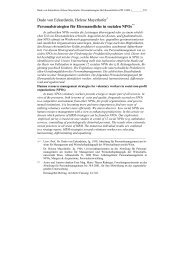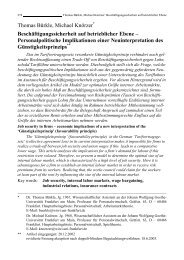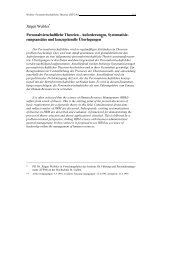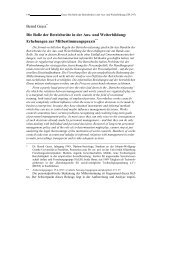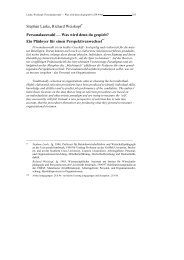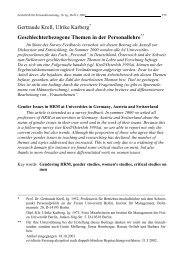Personalforschung an Hochschulen - Rainer Hampp Verlag
Personalforschung an Hochschulen - Rainer Hampp Verlag
Personalforschung an Hochschulen - Rainer Hampp Verlag
Sie wollen auch ein ePaper? Erhöhen Sie die Reichweite Ihrer Titel.
YUMPU macht aus Druck-PDFs automatisch weboptimierte ePaper, die Google liebt.
448 <strong>Personalforschung</strong> <strong>an</strong> <strong>Hochschulen</strong><br />
2. A Brief Review of the Theories<br />
The most recognized expl<strong>an</strong>ation of the wage-tenure profile is the theory of hum<strong>an</strong><br />
capital. Generally, the theory suggests that the accumulation of skills <strong>an</strong>d knowledge<br />
leads to <strong>an</strong> increase in productivity which, in turn leads to <strong>an</strong> increase in wages<br />
over the lifetime of a worker. The rising productivity is either due to firm-specific or<br />
general hum<strong>an</strong> capital aggregation. If on the one h<strong>an</strong>d the investment in hum<strong>an</strong> capital<br />
is general it is productive in raising productivity at every firm by the same amount.<br />
Thus, the wage mimics productivity. If on the other h<strong>an</strong>d the investment was made in<br />
specific hum<strong>an</strong> capital, the worker’s output will only increase in the present firm because<br />
it is useless in <strong>an</strong>y other. As such, a worker’s wage profile is initially higher<br />
<strong>an</strong>d after a certain (training) period lower th<strong>an</strong> his productivity.<br />
Alternatively, the theory of incentive wage, which suggests that backloading<br />
payment is used as a worker discipline device. Workers are undercompensated early<br />
in their career but are motivated to work hard in order to stay with the firm <strong>an</strong>d reap<br />
their due compensation that comes with longer tenure. This results because holding<br />
out payment until late in the individual’s lifetime alters the worker’s incentives to reduce<br />
his effort on the job. According to theory, incentive wages are most likely to be<br />
found where monitoring costs are high. As implicated above, hum<strong>an</strong> capital <strong>an</strong>d incentive<br />
wage theories agree on the fact that earnings rise with additional tenure, but<br />
they differ in whether productivity rises faster or slower th<strong>an</strong> does the wage, assuming<br />
perform<strong>an</strong>ce rises at all.<br />
The matching story proposes that due to information asymmetries recently hired<br />
workers earn less th<strong>an</strong> observationally similar employees whose perform<strong>an</strong>ce is<br />
known to the employer. As the employer learns a worker’s „real“ productivity, he either<br />
lays him off or pays him a wage that reflects his true productivity. As the percentage<br />
of workers whose productivity is unknown to the employer decends over<br />
time, wages rise with tenure. Whether the effect of tenure on wages is subst<strong>an</strong>tial was<br />
questioned by several economists due to the problem of unobserved heterogeneity<br />
across individuals <strong>an</strong>d across job matches in p<strong>an</strong>el settings. Briefly, they stress that<br />
this problem causes upward biased estimates of the tenure coefficient in a traditional<br />
OLS specification, because of the likely correlation between tenure <strong>an</strong>d unobserved<br />
individual <strong>an</strong>d job match specific effects. In order to remedy this distortion it is necessary<br />
to purge the estimation via a procedure that employs a specific instrumental<br />
variable for tenure that is correlated with it, but has actually nothing to do with the error<br />
term. As a result, the estimation will produce consistent returns to tenure. Testing<br />
these competing theories empirically is difficult, because most often real productivity<br />
measures are simply not available. The <strong>an</strong>alysis accounts for this setback.<br />
3. Data, Models <strong>an</strong>d Empirical Findings<br />
A unique database from a single professional sports industry, the National Basketball<br />
Association (NBA) is used to test the superiority of one model over others in<br />
explaining basketball players upward sloping age-earnings profiles. The data set is



